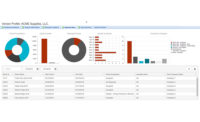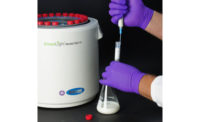New milk receiving measurement solutions improve dairy, cheesemaking operations

The milk receiving step at dairy and cheesemaking operations is critical to product quality. Dairy operations need measurement solutions that help deal with two key milk receiving issues – the aeration that occurs due to agitation in milk trucks traveling from the farm to the dairy plant; and the need to identify and measure the milk components. Older measuring solutions for these milk receiving issues are slow, costly and inaccurate. Now, new inline measurement devices are available that help with process optimization and quality improvement.
Transportation equals aeration
Milk receiving is traditionally done by the use of large platform scales onto which the milk trucks drive. Once unloaded, the amount of milk received is established by subtracting the net weight of the empty truck from the total weight recorded at arrival. This method is quite slow and results in an average error rate of at least 2%.
When a raw milk truck arrives at a dairy plant downloading station, the milk is always aerated due to the moving and shaking associated with transportation. Typically, during milk transfer there is also a significant amount of air introduced in the line at the beginning, since the air is trapped in the line and at the end when the milk level is low, due to the syphon effect.
Measurement by volume flow is an alternative to a weigh scale. However, most volumetric flow methods cannot distinguish air from milk. Therefore, any air in the transfer line leads to measuring errors. A more recently introduced technology for measuring incoming milk is the Coriolis mass meter. When an air pocket passes the meter during the start of a truck unloading cycle or at the end when the fluid is being syphoned, such a typical meter would stall and no longer measure at all.
De-aerators are used to remove the air in the milk. This adds costs and delays while significantly complicating the milk fluid transfer process. De-aerators also take up space and need to be maintained, cleaned and sterilized frequently.
Currently, it can take up to 30 minutes to unload a truck, and there may only be a certain limited number of loading bays. End users typically want to unload a truck as quick as possible, ideally in 4-5 minutes, so the next truck can unload, but current de-aerating processes do not allow this.
Dairy operators are looking for faster and more effective milk transfer for several reasons. One critical motivation is processing time. The faster milk moves from the farm to the pressurization stage, the safer it is for the product and the less risk of bacterial contamination. Every minute of additional processing adds to possible product degradation.
A new preferred option is the elimination of the de-aerator altogether. This can only be achieved with the use of new straight tubes Coriolis mass meter technology that incorporates an entrained gas management (EGM) system. For example, the new OPTIMASS developed by KROHNE Inc., Peabody, Mass., can handle the challenge of entrained gas during measurement without stalling the meter, and provides an overall accuracy on milk transfer to better than 0.2%.
New meter handles high air content
This new type of meter with EGM was used for flow measurement of raw milk at Frischli, a German dairy that manufactures individual coffee cream portions. The raw milk needed for production is supplied via two pipelines to several buffer tanks. The company used two regular mass flow meters, but found their measurements were repeatedly affected by the entrained aeration gas in the raw milk produced during transportation. The de-aeration tank could not fully eliminate the entrained air, thus affecting their meters and resulting in inconsistent performance and disruption of the signal processing, which then created significant measuring errors or loss of measurement altogether.
Once Frischli installed the OPTIMASS mass meters in front of the buffer tank, they were immune to the negative effects of entrained gas in raw milk. Using the EGM feature, the devices continuously measured the volume, mass and density, even with entrained gas varying from 0-100%. The problems of flow measurement caused by entrained gas have now been resolved, and now have continuous monitoring of the raw milk.
To optimize its operational processes, the dairy can now readily compare the incoming raw milk volume to the produced coffee cream.
Any dairy that is considering a new loading bay should compare a large platform scale with this type of flow measurement device. The OPTIMASS flow meter with the new EGM gas management feature provides a better overall accuracy while facilitating a faster transfer rate.
The importance of milk properties
Milk is an emulsion with different components, including water, protein, fat and lactose. Since dairy plant operators often pay suppliers based on the amount of fat and protein content received, they must be able to accurately measure these milk components. If the measuring method used results in even a 1% error, that equates to significant money per tanker truck load.
One significant measurement challenge is the variation of the measured fluid. During transportation, the milk settles into stratified layers and the fat rises to the top. For each tank load, the range of difference in fat can be as much as 3%, with 5% fat at the top and 2% on the bottom layer. Therefore, as milk is being unloaded from the bottom, the milk properties are continuously changing, from low to higher fat content.
Another key parameter in the production of cheese is the milk protein content. Higher protein content increases the yield of cheese that is produced. Therefore, raw milk that is rich in protein is better suited to high-margin cheese products than raw milk with low protein.
Certain types of cheese need specific amounts of protein. Pre-batching received milk with the right percentage of protein for these particular cheeses is often done, so plant operators can maximize production yield from each tanker load.
Increasing overall protein concentration in the raw milk reception tank by only 0.03% can conceivably result in about 1% more cheese produced. In addition, having a consistent ratio of protein to fat content in the tank makes it easier to control the production process.
Dairies that also produce milk or milk powder, cream and other products need to optimize the specific amounts of fat or protein in each product. Knowing how much of each constituent is in the received milk helps to manage the processes and maximize yields. An accurate accounting of the amount of fat and protein received vs the amount of product produced is used to determine a production plant’s overall efficiency and tune production line processes.
Measurement approaches
Laboratory measurement is traditionally used to determine the amount of protein and fat in a tanker truck load. At reception, using a large ladle, analysts simply take a sample from the top, middle and bottom of the truck or tank. They then put the three samples in individual vials and carry them to an on-site lab to analyze.
While the lab analyzer equipment itself is quite accurate (in the .03% range), the overall analysis process is affected by human error and a general lack of sample handling repeatability. Also, the presence of globules of fat in the samples leads to errors. Just a few fat globules (which are very large in raw milk) drawn into the sampling vial can dramatically change the sample concentration and may no longer be characteristic of milk quality. Mixing multiple samples into one composite sample is another traditional alternative for determining the overall amount of fat and protein received. However, this process still results in inaccuracy, depending on how representative this composite sample is compared to the full truck load. While providing more data points than the 3-vial method, this blending method still results in a nominal 1% inaccuracy rate.
Using an at-line analysis instrument that takes samples in-situ and analyzes them automatically is another alternative. These are lab analysis instruments that have been adapted with automatic sample handling systems. However, while measurement speed is better than the manual alternative, it is still relatively slow – about one measurement every 1-3 minutes. Furthermore, these devices are still drawing a small milk sample, and users must assume that these are representative of the whole milk.
These analyzers are at-line and cannot measure directly inline because of their traditionally used transmission-based measurement method. They feature a very small measuring gap (only a few micrometers) and are prone to issues caused by cold fluids or samples with high concentrations. The fat globules in cold milk are very large and tend to plug the measuring gap, so in many cases the milk needs to be pre-conditioned, either by heating it up or even homogenizing it, before sending it onto the analyzer itself. This demands complex and maintenance intensive equipment and can further slow the analysis process.
Most recently available are inline measurements that can continuously measure fat and protein in a constant flow of milk. These inline devices can continuously measure the whole fluid within the process pipe without any sampling. Such a device, the OPTIQUAD M spectroscopic analyzer from KROHNE, measures protein, fat and lactose in cheesemaking processes directly in-line with an accuracy comparable to a lab analyzer. The device combines four different measuring principles with up to 12 light sources over a wide spectral range. It can continually measure cold raw milk without any sample treatment directly in-line with a 3-second response rate.
This optical process technology can be used to improve dairy product quality while increasing productivity through yield increases and resource optimization. Based on real-time measurements, better batch reproducibility could be achieved through automatic control. Product safety and regulatory compliance can also benefit while cutting down laboratory analysis costs.
For example, Belgian dairy Fabrelac (now part of Friesl and Campina Ingredients) wanted to use automation to increase cheese yield by making full use of process information to maximize mozzarella output. As one of Europe’s leading suppliers of mozzarella, Fabrelac also wanted to achieve constant cheese quality, make the most of byproducts and save money by avoiding sampling activities. They previously used manual sampling with laboratory analysis to determine the milk protein and fat content of received milk. They wanted to eliminate the delay before the values could be used for process control.
Now, readings from OPTIQUAD devices installed in the two raw milk lines are used, along with the electromagnetic flowmeter in the same line, to report the average fat and protein content of the raw milk streams. Measured values from another device installed behind the buffer tanks are used to standardize the protein and fat content during cheese milk preparation. Fabrelac can now assess the quality of raw and cheese milk, allowing them to dynamically re-adjust operating parameters at every production stage.
Another European producer of dairy products offloads tanker trucks delivering raw milk using an open drain system that feeds the milk into a buffer tank. To achieve a cheese yield increase, the company decided to improve the milk reception process by supplying the delivered raw milk with high-protein content into a separate storage tank. They needed a measurement solution that could continuously provide precise readings of the protein content in delivered raw milk, so they could run an a PLC-based automated control system and control the valves of the pipeline feeding the two storage tanks depending on the protein content measured. They also wanted to measure the fat and lactose content.
After installing the OPTIQUAD spectroscopic analysis system, they were able to provide exact readings of protein, fat and lactose content every 10 seconds. The new system allows them to separately collect raw milk with above-average protein quantities. The new raw milk storage process also allows them to raise the protein content in relation to the fat content even before the separation, which can lead to a significant cheese yield increase. They can also calculate the fat and lactose ratio in the raw milk delivered.
New measurement technology benefits automated processes
Many dairy and cheesemaking operations are moving toward complete automation for process optimization and quality improvement. New measurement technology is ideal for increasing protein content in cheesemaking milk or vat milk, standardizing fat content or setting a constant ratio of fat to protein in cheese production.
Looking for a reprint of this article?
From high-res PDFs to custom plaques, order your copy today!





